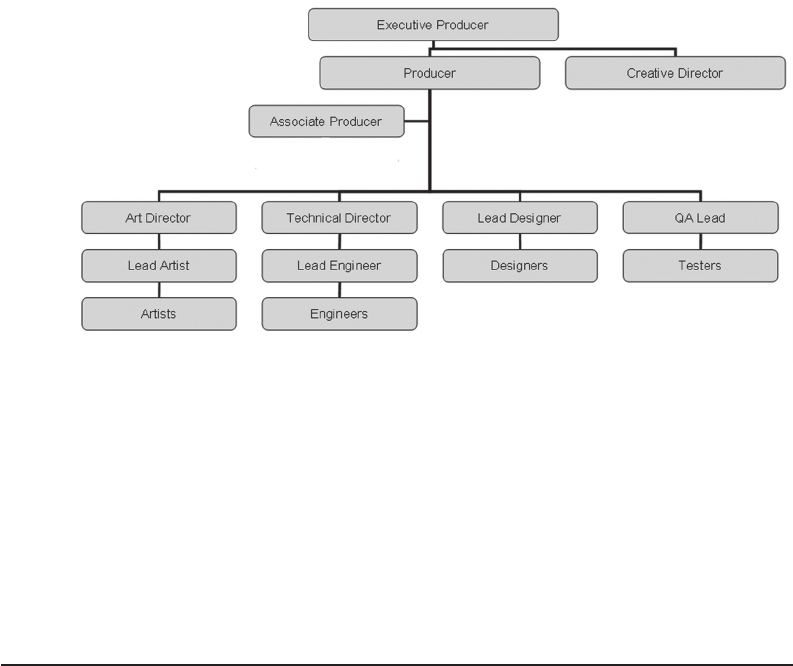
ROLES ON THE TEAM 37
FIGURE 2.6 Team with executive producer structure.
director is in charge of managing the creative vision of the game. This reporting
structure might be different for each development team.
This structure also indicates that the leads are the intermediaries between
the directors and the rest of the team. In addition, a production coordinator is
added to assist the associate producer with day-to-day tasks. This is especially
helpful if the associate producer is managing several areas of the game, such as
localizations and the voiceover recordings.
2.8 CORPORATE
Any full list of game credits includes recognition of all the corporate people
who are integral to creating and launching a successful game. People in these
roles are usually working for the publisher, and are responsible for creating
the packaging, marketing campaign, sales plan, and anything else that supple-
ments the actual game. These people normally communicate with the producer
and are treated as external members of the development team. These depart-
ments include the following:
■
Marketing and Public Relations
■
Creative Services
■
Sales
Marketing and Public Relations
The main responsibility of the marketing department is to market the game
to the target consumer. Their challenge is building a compelling marketing
38 THE GAME PRODUCTION HANDBOOK, 2/E
campaign around the game’s features, story, and gameplay experience that
entices players to buy the game. To be most effective, marketing should be in-
volved with the game during pre-production. This involvement gives them the
opportunity to suggest features and other ways to make the game more market-
able. For example, they might suggest using licensed music from a popular band,
casting celebrity voices, or adding some unique new gameplay features.
Public relations (PR) is responsible for generating publicity for the game
through websites, magazines, and television spots. This process includes set-
ting up interviews with the development team and organizing press tours for
the game. In addition, they create unique publicity events to get players asking
questions about the game. Marketing and public relations work together closely
to ensure that they are both presenting a unified vision of the game to the tar-
get audience. Please refer to Chapter 13, “Marketing and Public Relations,” for
more information.
Creative Services
Creative services works closely with the marketing department to create the
packaging and manual for the game. After the look and feel of the packaging is
decided, creative services generates the necessary assets, creates the final layout,
and coordinates the printing of all the materials.
Because the producer is more familiar with the game than someone in the
creative services department, the producer is expected to provide the manual
text, screenshots, and other game assets for the printed materials. See Chapter 13,
“Marketing and Public Relations,” for more information on the process for cre-
ating the packaging and manual.
Sales
The sales department is responsible for selling the game to retail stores, such as
Wal-Mart, EB Games, and Best Buy, as well as on-line providers, such as IGN’s
Direct2Drive. They also determine whether special editions of the game can be
created to increase sales. For example, a special edition of the game may be created
that includes game-related merchandise, a strategy guide, and other premiums.
2.9 CHAPTER SUMMARY
With so many people involved in creating games, the producer must understand
everyone’s roles and responsibilities on the team. This chapter presented general
overviews of the production, art, engineering, design, testing, and corporate
roles on a team and briefly discussed the background and training necessary for
these roles.
ROLES ON THE TEAM 39
With a clear understanding of team roles, the producer can decide on the
appropriate team structure and production process to use when developing a
game. The next chapter discusses some formal production processes that can be
effectively used on development teams, including the Personal Software Process
and agile methodologies.
..................Content has been hidden....................
You can't read the all page of ebook, please click here login for view all page.
